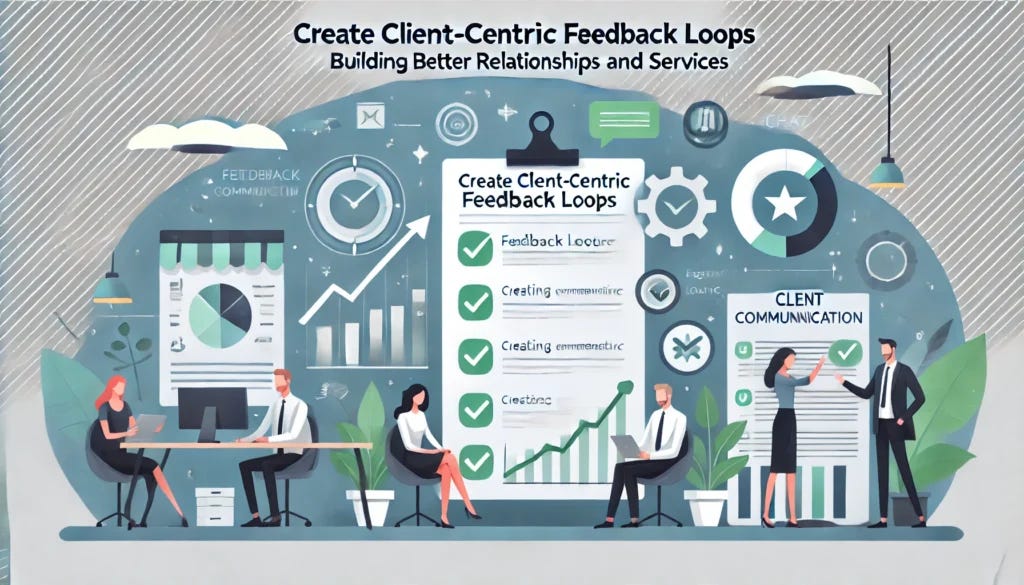Create Client-Centric Feedback Loops: Building Better Relationships and Services
A CatalystFactor Blog
Client satisfaction is a cornerstone of success in professional services. However, many firms struggle to understand their clients' evolving needs and expectations. Creating client-centric feedback loops is a powerful way to stay aligned with your clients, improve service delivery, and foster long-term relationships. You can drive meaningful improvements and reinforce trust by actively seeking, analyzing, and acting on client feedback.
Feedback isn’t a one-time task; it’s an ongoing process that ensures your firm stays aligned with client needs in a competitive market.
The Challenge: Disconnects Between Firms and Clients
Without effective feedback mechanisms, firms often face several challenges:
Unmet Expectations: Clients may feel their needs aren’t fully understood or addressed.
Missed Opportunities: A lack of feedback limits your ability to identify areas for growth or innovation.
Erosion of Trust: When clients perceive a gap between their expectations and your delivery, relationships can suffer, even if the issues are minor.
These disconnects can lead to decreased client satisfaction, reduced retention rates, and missed chances to upsell or cross-sell services.
The Solution: Implement Client-Centric Feedback Loops
Feedback loops create a continuous cycle of collecting, analyzing, and acting on client insights to improve services and strengthen relationships. Here’s how to build an effective client-centric feedback system:
1. Ask for Feedback Regularly
Create multiple touchpoints for gathering client input, such as:
Post-Project Surveys: Assess satisfaction with specific deliverables.
Quarterly Check-Ins: Discuss ongoing needs and long-term goals.
Real-Time Feedback: Use tools like live chat or email surveys to capture insights during engagements.
2. Use Open-Ended Questions
Combine quantitative metrics with open-ended questions to uncover deeper insights. For example, ask, “What could we have done differently to enhance your experience?”
3. Leverage Technology
Use customer feedback management tools like SurveyMonkey, HubSpot, or Typeform to streamline data collection and analysis. Advanced tools with analytics capabilities can identify trends and highlight actionable insights.
4. Analyze Feedback for Patterns
Don’t just gather feedback—analyze it. Look for recurring themes in client concerns or requests. For example, if multiple clients mention slow response times, it’s a signal to improve communication processes.
5. Act on Feedback
Show clients that their input matters by taking action. Prioritize changes based on feedback and communicate how you’re addressing their suggestions.
6. Close the Loop
Follow up with clients to share updates on how their feedback has been implemented. This step reinforces trust and demonstrates your commitment to continuous improvement.
7. Create Feedback Channels Across All Stages
Don’t limit feedback to the end of a project. Collect insights throughout the client journey to ensure alignment at every stage.
The Result: Improved Satisfaction, Loyalty, and Growth
When firms create client-centric feedback loops, the benefits are significant:
Higher Satisfaction: Clients feel heard and valued, strengthening trust and engagement.
Enhanced Services: Acting on feedback helps refine your offerings, ensuring they meet or exceed client expectations.
Increased Retention and Referrals: Satisfied clients are likelier to stay loyal and recommend your services to others.
For instance, an architectural firm introduced quarterly feedback sessions with key clients. By addressing recurring concerns about project timelines, they implemented new scheduling tools that improved delivery rates by 20% and increased client satisfaction scores by 30%.
Closing Thoughts
Creating client-centric feedback loops isn’t just a best practice—it’s a strategic advantage. By listening to your clients, acting on their insights, and closing the loop with thoughtful communication, you can build stronger relationships and deliver exceptional value. Start building your feedback loops today—your clients and your business will thank you.





